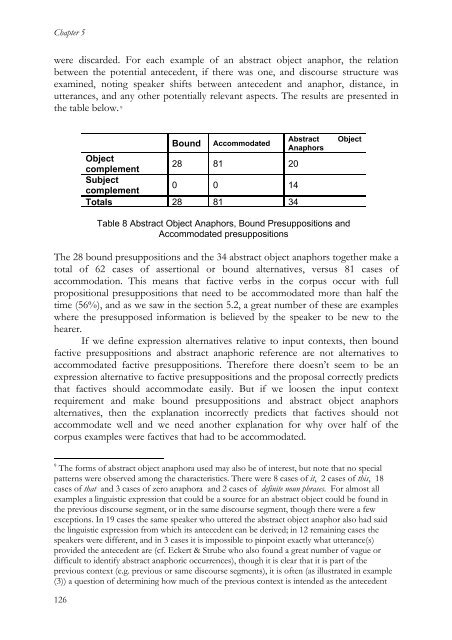Presuppositions in Spoken Discourse
Presuppositions in Spoken Discourse
Presuppositions in Spoken Discourse
Create successful ePaper yourself
Turn your PDF publications into a flip-book with our unique Google optimized e-Paper software.
Chapter 5<br />
were discarded. For each example of an abstract object anaphor, the relation<br />
between the potential antecedent, if there was one, and discourse structure was<br />
exam<strong>in</strong>ed, not<strong>in</strong>g speaker shifts between antecedent and anaphor, distance, <strong>in</strong><br />
utterances, and any other potentially relevant aspects. The results are presented <strong>in</strong><br />
the table below. 9<br />
126<br />
Bound Accommodated<br />
Abstract<br />
Anaphors<br />
Object<br />
Object<br />
complement<br />
28 81 20<br />
Subject<br />
complement<br />
0 0 14<br />
Totals 28 81 34<br />
Table 8 Abstract Object Anaphors, Bound <strong>Presuppositions</strong> and<br />
Accommodated presuppositions<br />
The 28 bound presuppositions and the 34 abstract object anaphors together make a<br />
total of 62 cases of assertional or bound alternatives, versus 81 cases of<br />
accommodation. This means that factive verbs <strong>in</strong> the corpus occur with full<br />
propositional presuppositions that need to be accommodated more than half the<br />
time (56%), and as we saw <strong>in</strong> the section 5.2, a great number of these are examples<br />
where the presupposed <strong>in</strong>formation is believed by the speaker to be new to the<br />
hearer.<br />
If we def<strong>in</strong>e expression alternatives relative to <strong>in</strong>put contexts, then bound<br />
factive presuppositions and abstract anaphoric reference are not alternatives to<br />
accommodated factive presuppositions. Therefore there doesn’t seem to be an<br />
expression alternative to factive presuppositions and the proposal correctly predicts<br />
that factives should accommodate easily. But if we loosen the <strong>in</strong>put context<br />
requirement and make bound presuppositions and abstract object anaphors<br />
alternatives, then the explanation <strong>in</strong>correctly predicts that factives should not<br />
accommodate well and we need another explanation for why over half of the<br />
corpus examples were factives that had to be accommodated.<br />
9 The forms of abstract object anaphora used may also be of <strong>in</strong>terest, but note that no special<br />
patterns were observed among the characteristics. There were 8 cases of it, 2 cases of this, 18<br />
cases of that and 3 cases of zero anaphora and 2 cases of def<strong>in</strong>ite noun phrases. For almost all<br />
examples a l<strong>in</strong>guistic expression that could be a source for an abstract object could be found <strong>in</strong><br />
the previous discourse segment, or <strong>in</strong> the same discourse segment, though there were a few<br />
exceptions. In 19 cases the same speaker who uttered the abstract object anaphor also had said<br />
the l<strong>in</strong>guistic expression from which its antecedent can be derived; <strong>in</strong> 12 rema<strong>in</strong><strong>in</strong>g cases the<br />
speakers were different, and <strong>in</strong> 3 cases it is impossible to p<strong>in</strong>po<strong>in</strong>t exactly what utterance(s)<br />
provided the antecedent are (cf. Eckert & Strube who also found a great number of vague or<br />
difficult to identify abstract anaphoric occurrences), though it is clear that it is part of the<br />
previous context (e.g. previous or same discourse segments), it is often (as illustrated <strong>in</strong> example<br />
(3)) a question of determ<strong>in</strong><strong>in</strong>g how much of the previous context is <strong>in</strong>tended as the antecedent











